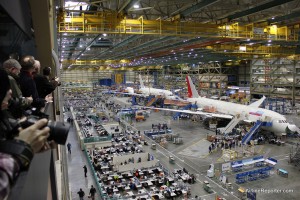
The Boeing 787 Dreamliner line inside the Boeing Factory. Here are 787s for Air India, JAL and China Southern.
During the Boeing 747-8 Intercontinental event, invited guests were allowed into factory to not only take a look at the Boeing 747-8I and 747-8F, but also the Boeing 777 Worldliner and Boeing 787 Dreamliner.
This is a huge treat, since Boeing normally doesn’t allow people to take photos inside the factory, but this time, cameras were allowed and I had a hard time cutting over 300 photos down to just 26.
I already posted photos being on the factory floor with the 747-8, but now it is time to share some photos of the 787 and 777. Unfortunately, we still weren’t allowed down on the factory floor with the 787, but we were able to get up close and personal with the 777 line.
VIEW ALL 26 PHOTOS OF THE 777 AND 787 LINES
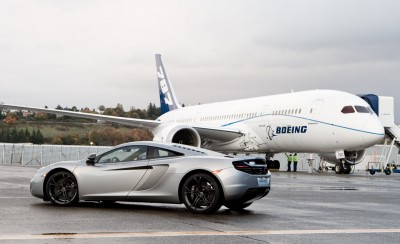
Boeing 787 Dreamliner ZA003 and a 2012 McLaren MP4-12C at Paine Field. Yea, I will take two of each, thanks.
As a fan of airplanes and cars, I got very excited seeing a 2012 McLaren MP4-12C with a Boeing 787 Dreamliner in my most recent Road and Track magazine. Looks like the magazine had the car at Paine Field and over to the Future of Flight for some photos.
They also had a great interview with Mike Sinnett who is the Vice President, 787 Chief Project Engineer at Boeing. The magazine asks Sinnett about the carbon fiber used in the Dreamlinrer. Head on over the RoadandTrack.com for the full interview.
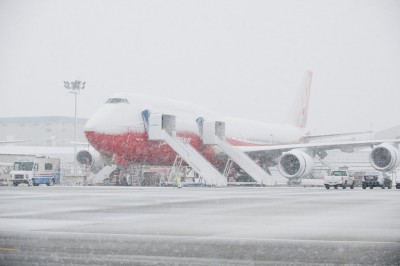
The first Boeing 747-8 Intercontinental (N6067E)outside in the snow with its orange livery. Click for larger.
What is orange and white and awesome all over? The Boeing 747-8 Intercontinental in a snow storm of course (yes, bad I know).
Yesterday Paine Field saw a little bit of snow and Boeing was great enough to get out in and take this shot of the 747-8I seeing her first snow fall.Even in the snow, that bright orange really comes through. She is one gorgeous airplane.
Thank you Boeing for sharing this photo!
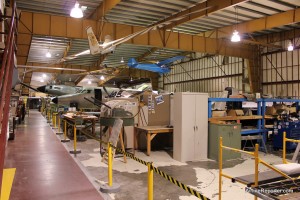
This is just one half of one of the hangars at the Museum of Flight's Restoration Center at Paine Field.
A while back I had the opportunity to check out the Museum of Flight at Boeing Field (KBFI), just south of Seattle. They have an amazing collection of aircraft and any aviation geek can find something of interest. They have vehicles on display that are covered in fabric to being found in space. Creating such an amazing collection doesn’t come easy and it takes an enormous amount of work to get old airplanes to museum quality. Where many visitors (and locals) will check out the Museum of Flight, many don’t get the whole story. A visit to check out the Museum of Flight Restoration Center, housed at Paine Field (KPAE), is a must for any aviation enthusiast.
The restoration work is mostly done by volunteers who use their time, skills and rarely even their own money to help restore the museum’s aircraft. These are people with a true passion for aviation and talking with them about their work is more exciting than viewing the actual airplanes. The facility employs only two staff, but has a roster of about 75 volunteers. The entire Aircraft Collections Department in Seattle and Everett, has a staff of three and over 125 volunteers. Volunteers will be broken up into teams and assigned to work on an aircraft. Director of Aircraft Collections and the Senior Curator will determine what needs to be done and work with the volunteers on the proper methods to do it. Since many parts can no longer be found or are too costly, in many cases, they end up making their own.
Restoring an airplane is difficult enough, but keeping it in good shape is a whole other ballgame. Most of the aircraft at the Museum of Flight and the Restoration Center are housed inside, which makes keeping them in prime condition easier. The challenge becomes the ones that live outside in the punishing Seattle weather. The Museum of Flight is in process of creating an indoor airpark to house the airliners that are outside now and the others (ie Comet, 1st 727 and Constellation) waiting to be put on display.
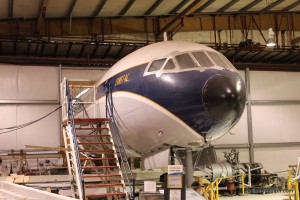
It becomes a challenging juggle between man-power, resources, money and time to keep such a large collection in pristine condition. The Restoration Center’s goal is not to get the aircraft to flying condition, but in a condition that they preserve the history of the aircraft type and of the individual plane. If the plane has damage on it, that can tell a story. They might not fully repair it since it is a part of the history of the aircraft.
Probably one of the most difficult tasks at the Museum of Flight or the Restoration Center is having to tell someone, “no,” when they have an aircraft that they want added to the collection. Boeing Field, where the Museum of Flight is located, is crowded and very expensive. Although the Restoration Center has been successfully expanding their hangar space at Paine Field throughout the years, it is becoming more difficult with the increased popularity.
Walking into the main lobby of the Restoration Center, you will find aviation related items almost everywhere. Although the lobby has some interesting things, it doesn’t compare to what you will find in the main hangar. When first entering the hangar, I had to pause and absorb everything. From old war birds, to military jets, to the front end of a Comet 4C sticking inside the hangar — I knew this was going to be a great visit. I am glad I had Tom Cathcart and TC Howard there to keep me on track or I might have just endlessly been wondering around the facility.
There are many wonderful planes with interesting stories (see all the photos), but here are three of my favorites:
THE DE HAVILLAND COMET 4C
I have seen the rear end of this plane sticking out of the hangar for many years, but had never made it inside. It is quite the site to see half the aircraft in the hangar and the rear half sticking out. This of course has caused some issues with the front being protected and the rear half being exposed to the elements. They are in the process of putting up a protective cover for the rear of the aircraft. This will make the view from outside less exciting, but it will keep the plane from deteriorating — which is well worth it.
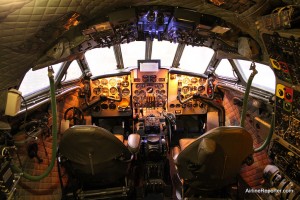
The wonderfully restored cockpit of the Comet 4C.
Stepping inside the Comet was like traveling through time. As I climbed on board, I tried to imagine what it must had been like for passengers to fly on a Comet for the first time. The Comet was the first production jet airliner and was a huge difference from their prop counterparts. What excitement passengers must have felt flying on a new generation or airliner. Yes, the Comet had some “breaking up in midair” issues at first, but by the time the Comet 4C came around, they had that sorted out.
This aircraft is being restored from the front to the back, which provides a nice insight on the process. The lavatory looked almost brand new and it was surreal seeing the photo on the wall showing what it looked like when they got the aircraft.
This exact aircraft (C/N 6424) had her first flight on October 31, 1959 and was delivered to Mexicana in July of 1960. The airplane was abandoned at Paine Field in 1979 before it was taken by Everett Community College for their students to work on. The problem was, it was a British aircraft and provided little help for American students learning how to work on American aircraft. Here is some more to explore:
* My photos of the Comet 4C during my visit
* More about the Comet 4C on the Museum of Flight’s website
* Some photos of the Comet’s restoration on Bob Bogash’s page
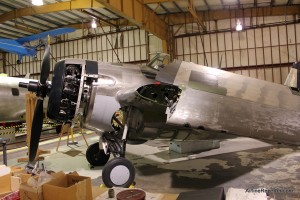
The Wildcat where you can see the new skin they put on versus the original on the wing.
THE FM-2 WILDCAT
The Wildcat is one slick plane, but I was mostly fascinated with how they have been restoring it. Like many of the other planes the Restoration Center receives, the plane wasn’t in the best of shape — it has been sitting at a park for many years. Since parts are difficult, expensive and time consuming to come by, 60% of this aircraft has been re-done in-house. You could see how some of the old skin on the aircraft remained, but much of is has been recently re-fabricated and placed on the aircraft.
On a work table there was a drawing, a paper mock up and a formed wood piece all made to re-make a part of the wing. The volunteers working there are a very creative and motivated group of people.
THE FIRST BOEING 727 (N7001U)
Ah, the first aircraft of a particular aircraft type is always a fun find. The Boeing 727-100 housed in the back of the Museum of Flight’s Restoration Center is N7001U and was the first 727 ever produced. After completing her flight testing, she served a long career with United Airlines. Unlike most other Boeing test programs, there was no dedicated test aircraft for the 727 program. The first one built was used for testing and then put into service.
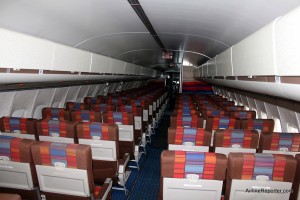
The interior of the 727 looks almost like it did when it was delivered. Can you see the obvious difference?
The plane was delivered to United on October 6, 1964 and after her long career, was delivered to the Museum of Flight in January 1991. Between that time, the aircraft flew almost 65,000 hours, made over 48,000 landings and few about 3 million passengers. The plane was configured to have the same livery and interior it had when it was first sold to United in 1964. At the time, the aircraft was gorgeous and still flight worthy. Unfortunatly United ended up removing many parts needed to keep the aircraft airborne and the Restoration Center has been working since to get this beauty back in the air.
That’s right. The goal is not to just to keep the aircraft in good shape, but also to get it where she can be flown from the Restoration Center at Paine Field, south about 30 miles to Boeing Field. It is a race against time to put new parts on the airplane while making sure it stays in good condition. In the past five years they have gotten parts donated from Clay Lacey’s old Boeing 727-200 (the cockpit is on display at the Future of Flight) and from Marcella, the Eastern Air Lines turned FedEx Boeing 727-200, whose front end is housed at the Future of Flight.
Much like walking into the Comet, the interior of the Boeing 727 takes you back in time. The colorful seats, the brown wallpaper and of course that very colorful carpet on the bulkhead. The cockpit looked like she was ready to fly and hopefully someday she might get that chance. Here is some additional information and photos of N7001U:
* My photos of N7001U inside and out
* Photos and information on the first 727 on the Museum of Flight’s site
* Additional information from Bob Bogash’s site
* Photo of the 727 in United Airline Tulip Livery
* Photo of the 727 in United Friendship Livery
The Restoration Center is not just a great place to visit, but to also learn how the restoration process works. I know many of you that read this blog have skills that could be very useful with many of their projects. If you are looking for something to do to keep you busy and you want to help out with history, the Restoration Center is always looking for dedicated people to help out. Otherwise, you are always welcome to visit (it only costs $5) to see the restoration process for yourself.
If you want more eye candy, be sure to check out the additional photos. This review will be added to my Aviation in Seattle page.
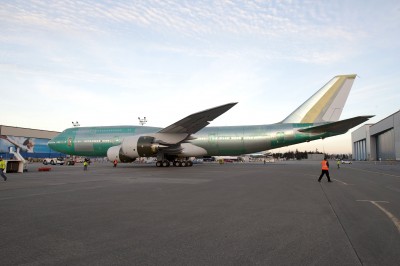
The First Boeing 747-8 Intercontinental gets some fresh air at Paine Field. Click for a MUCH larger version. Photo by/from Boeing.
We are now less than two weeks, away from the official roll out of the first Boeing 747-8 Intercontinental. On the Sunday the 31st this photo was taken by Boeing as the plane was being moved over to the paint hangar. In less than two short weeks on February 13th at about 11am, the aircraft will officially be unveiled to the world at a special ceremony at the Boeing factory.
The lucky folks who attended Aviation Geekfest 2010 were able to get a glimpse of the first 747-8I in person and I have to say she is one very beautiful bird. You better believe I will be there to see her debut on the 13th — it is a special valentines day gift for us airline geeks.
For those of you able to come hang out at Paine Field on the 13th, I invite you to come early, check out the Future of Flight and Boeing factory tour for a possible glimpse of the aircraft before it is unveiled to the world.
Still no word on who the owner of this amazing plane will be. I am told it is a private buyer and I know that all eight Boeing Business Jet orders for the 747-8 are for governments. If anyone is able to track down the owner, that would be awesome to share either via comments or always confidential via email (da***@*************er.com)








